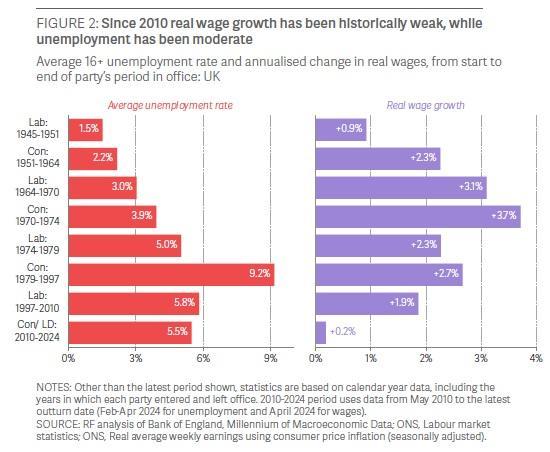Labour Market Backdrop To The Election Is Average Weekly Wages Growing By Just £16 Since 2010, As Parties Take Contrasting Approaches To Work In Their Manifestos
26th June 2024

The labour market backdrop to the election is a prolonged pay squeeze that has left real average wages today just £16 a week higher than in 2010, a job market struggling to recreate the 2010s boom, and the main parties taking very different approach to the world of work. New Resolution Foundation research published on Tuesday 25 June 2024.
Job done? - the latest Resolution Foundation election briefing, funded by the Nuffield Foundation - says that the most striking labour market feature of the past 14 years has been Britain's unprecedented pay squeeze.
Despite the welcome return of strong real wage growth in recent months, three shocks to pay packets in a little over a decade - the financial crisis, Brexit referendum and cost of living crisis – have left real average earnings today just £16 a week higher than they were fourteen years ago at the time of the 2010 election. In the 14 years prior to that election, average real wages grew by £145 a week in total (1996-2010).
While many countries have performed poorly on pay since 2010, the report notes that Britain's performance has been particularly bad. Had the UK matched the pay growth of Germany and the US over this period, average wages in Britain today would be £3,600 a year higher.
One important bright spark however has been the relatively strong performance among Britain's lowest earners.
The minimum wage, which was ramped up in 2016 by then Chancellor George Osborne, has helped to ensure that real typical hourly pay for low-paying occupations such as cleaners, waiters, bar staff and shop assistants has grown by at least 20 per cent since 2010 (compared to typical pay growth across the workforce of 1.6 per cent). As a result, hourly wage inequality between low and median earners has fallen to its lowest level since at least the mid-1970s.
Employment growth since 2010 has been far more impressive, say the authors, particularly during the 2010s, when the UK’s employment rate increased from 70.3 per cent at the start of 2010 to reach a record 76.2 per cent on the eve of the Covid-19 pandemic.
However, around a third of this jobs growth has been lost over the pandemic and cost-of-living crisis, with the employment rate falling back to 74.3 per cent in February-April 2024. The UK is one of just six OECD economies – alongside Latvia, Iceland, Chile, Colombia and South Africa – that has yet to return to its pre-pandemic employment rate.
The rise in the total number of people in employment since 2010 is flattered by population growth, say the authors, with the share of people in employment increasing far less.
The Foundation notes that there are areas of consensus and conflict in how the two main parties are approaching the labour market in their manifestos.
Both parties share similar ambitions to boost employment over the next parliament, but propose different broad directions for policy with little detail. The Conservatives plan to use tax cuts, disability benefit cuts, and stricter conditionality to encourage more people into work, while Labour is focusing on providing greater career, skills and health support.
The recent cross-party consensus over a higher minimum wage has also started to fray. Having successfully ramped up the National Living Wage since 2016 so that it is now one of the highest minimum wages in the world, the Conservatives now want to put any further ramping up on hold – allowing it to rise in line with typical earnings rather than make further progress in closing the gap with them. Labour has an ambitious-sounding pledge to make the minimum wage a "genuine living wage", but it is unclear what that means in practice.
Finally, the report says there is clear blue water between the parties over employment regulation. The Conservatives are taking a business as usual approach, with no plans to introduce new rights or take forward the remaining aspects of Theresa May’s Good Work agenda. In contrast, Labour has pledged a range of policies – from a Fair Pay Agreement in social care, to bolstering sick pay and strengthening employment rights – that look likely to amount to the biggest shake-up of the workplace in a generation.
However, the scale of Labour’s changes will ultimately depend on the detail to be consulted on after the election. For example, potentially contentious reforms like providing ‘day one’ rights against unfair dismissal will be less far reaching, and less controversial for employers, if they are accompanied by provisions for probation periods for new starters.
Hannah Slaughter, Senior Economist at the Resolution Foundation, said:
"Britain’s prolonged pay depression has left average earnings just £16 a week higher than they were back in 2010, despite the welcome return of rising real wages in recent months. Worryingly, Britain’s decade-long jobs boom during the 2010s has also gone bust, with the UK one of only a handful of countries where employment has yet to return to pre-pandemic levels.
"Both the main parties want stronger jobs growth over the next parliament, but offer very different approaches to achieving it. The Conservatives want to use carrots and sticks in the tax and benefits system, while Labour is prioritising career, skills and health support.
“The Conservatives’ business-as-usual approach to the minimum wage and employment rights stand in stark contrast to Labour’s plans for the biggest shake-up of the workplace in a generation. But while the big labour market challenges facing Britain offer reasons for bold new policies, the combined scale of these reforms means they should be implemented carefully and after consultation.
Read he full Resolution Foundation report HERE
Pdf 36 Pages
